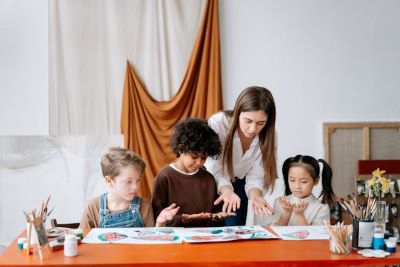Art education transcends the boundaries of paintbrushes and canvases. It shapes critical thinkers, problem-solvers, and visionaries. Creativity isn’t limited to the art room; it flows into every facet of life, driving innovation and adaptability. When nurtured early, artistic skills develop into lifelong assets that influence personal growth, career success, and societal contributions. In today’s fast-paced and tech-driven world, fostering creativity through art education has become more crucial than ever. From sharpening cognitive abilities to promoting cultural awareness, art education serves as a powerful catalyst for holistic development. Let’s delve into the multifaceted benefits of an art education and why it remains a cornerstone of both individual and collective progress.
Art Education Builds Critical Thinking Skills
An art education trains the brain to approach challenges from diverse perspectives. Engaging in artistic endeavors requires a balance of logic and intuition. When students analyze the proportions of a sculpture or interpret the symbolism in a painting, they exercise critical thinking skills. This ability to dissect problems and envision solutions proves invaluable beyond the art classroom. For instance, brainstorming design solutions or mapping out the steps in a complex project relies on the same cognitive processes. These skills also translate into better decision-making, enhancing careers in fields like business, science, and technology. Art education doesn’t just teach creativity; it cultivates intellectual agility and resilience.
Inspiring Creativity That Drives Innovation
Art fosters the creative mindset essential for innovation. Artists transform ideas into tangible creations, a skill equally relevant in entrepreneurship and technology. Whether designing groundbreaking apps or developing sustainable solutions for global challenges, creativity acts as the engine of progress. Pursuing structured art education programs, such as an online Master of Art in Teaching, provides a platform to refine this creativity. It equips individuals with the tools to teach and inspire others while honing their own innovative thinking. This dual impact underscores the importance of art education as a driver of personal and societal transformation. It’s about more than drawing or sculpting; it’s about redefining boundaries.
Enhancing Emotional Intelligence Through Art
Art cultivates emotional intelligence, a skill vital for personal and professional relationships. Creating or experiencing art engages empathy and emotional awareness. For instance, interpreting a poignant photograph or expressing oneself through painting allows individuals to connect deeply with their emotions. Students learn to process feelings constructively, fostering self-awareness and communication. These skills become particularly valuable in leadership roles, where understanding diverse perspectives is key. By engaging with art, individuals develop a sense of compassion and an ability to navigate complex human dynamics. This emotional growth supports healthier interactions and better conflict resolution in every aspect of life.
Boosting Cognitive Abilities and Academic Success
Art education strengthens cognitive abilities like memory, focus, and problem-solving. Activities such as learning musical instruments or mastering intricate dance routines require mental discipline and precision. These exercises boost neural connections, improving overall brain function. Studies show that students involved in the arts often excel academically, outperforming their peers in math, science, and reading. This correlation stems from the brain’s enhanced capacity to organize and retain information. Moreover, art encourages a growth mindset. When students tackle creative challenges, they learn perseverance and adaptability. These traits not only contribute to academic success but also prepare individuals to face life’s uncertainties with confidence.
Nurturing Cultural Awareness and Global Perspectives
Art acts as a bridge between cultures, fostering appreciation for diversity. Through exposure to global art forms, students gain insights into different traditions, histories, and values. This awareness encourages inclusivity and broadens perspectives. For example, studying indigenous art or exploring Renaissance masterpieces reveals the richness of human expression across time and geography. Such experiences create culturally sensitive individuals who thrive in an increasingly interconnected world. Art education instills respect for cultural heritage while inspiring innovative interpretations of these influences. By understanding the world through an artistic lens, individuals become better equipped to navigate and contribute meaningfully to global conversations.
Promoting Collaboration and Teamwork
Art education often involves group projects, performances, or exhibitions, encouraging collaboration. Whether rehearsing for a play or working on a mural, students learn to communicate effectively and combine diverse talents. This teamwork fosters mutual respect and problem-solving skills. Collaboration in the arts mirrors real-world scenarios where interdisciplinary cooperation is crucial. It teaches individuals to appreciate varying viewpoints and achieve shared goals. These lessons extend to professional settings, where teamwork drives innovation and productivity. The ability to work harmoniously with others becomes a lifelong advantage, ensuring success in both personal and professional endeavors.
Art education shapes well-rounded individuals who thrive in diverse aspects of life. It enhances cognitive skills, emotional intelligence, and cultural awareness while fostering creativity and adaptability. Beyond personal growth, it strengthens communities and addresses societal challenges through innovation and collaboration. The benefits of art education extend far beyond the classroom, touching careers, relationships, and mental well-being. Investing in art education is investing in the future—a future driven by creative, empathetic, and capable individuals. As we continue to evolve, the role of art education remains indispensable, ensuring progress and harmony in an ever-changing world.

